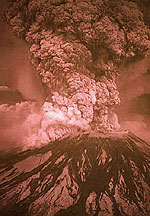Volcanoes! Lesson 1 Activity 1:
How Volcanoes Grow
Skip Navigation | Introduction | Download |
Lessons: 1 | 2 | 3 | 4 | 5 | 6
Lesson Activities: 1.1 | 1.2 | 2.1 | 2.2 | 3.1 | 3.2 | 4.1 | 4.2 | 5.1 | 5.2 | 6.1 | 6.2
Teacher Guide: About the Lessons | Glossary | Bibliography
(For grades 4-8)
- 45-minute work session
- 45-minute demonstration and discussion
- In small groups, students build models of the three major types of volcanoes and see how a volcano's shape is related to the type of material it erupts. As a class, they observe a demonstration that simulates the nature of two volcanic materials: lava and tephra. The lesson concludes with a discussion of how a volcano's shape is related to the nature of the material it erupts.
Key
- A volcano is a circular or linear opening in the Earth's surface through which lava, rock fragments, ash, aerosols, and gases erupt.
- A volcano is also the landform, often a mountain, built from repeated eruptions.
- Some eruptions are explosive, some are effusive (loosely flowing) and nonexplosive, and some are both explosive and effusive.
- There are three major types, or shapes, of volcanoes: (a) stratovolcano, (b) shield volcano; and (b) cinder cone.
Materials
Work Session
- Master Sheets (in PDF) 1.1, 1.2, and 1.3
- Colored marking pens (optional)
- Three 8 ˝ " x 11" transparencies for overhead projection
- Playdoh® in several colors
- Construction paper or cardboard, three pieces for each group of four students
- Pencils
Demonstration
- Three pie plates
- Three 1-cup measuring cups
- Cat litter
- Chilled molasses
Procedures
 |
- Explain that the photograph on the left was taken during the 1980 eruption of Mount St. Helens, a volcano located in the western United States.
- Introduce the concept that a volcano is both an opening in the Earth's surface through which magma erupts and a landform.
- Discuss the types of materials that can be erupted: lava, tephra, cinders.
- Discuss the different styles of eruption: explosive and nonexplosive.
- At this point, do not name the three major volcanic shapes.
- Divide the class into groups of four students each. Distribute to each group:
- Master Sheets 1.1, 1.2, and 1.3
- Three pieces of cardboard or construction paper
- Play-doh®
- Using the Master Sheets as guides, each group of students creates a two-dimensional relief model for each of the three types of volcanoes. Master Sheet 1.1 is a stratovolcano, Master Sheet 1.2 is a cinder cone, and Master Sheet 1.3 is a shield volcano.
- Ask each group of students to list the similarities and differences among the shapes and composition of the three types. (The shield is broad; the stratovolcano has steep sides; the cinder cone is the smallest; and the shield has only layers of lava.)
|
Discussion
- On a chalkboard, compile a class list of similarities and differences for each of the three types.
- Brainstorm why the volcanoes are different. For example, lava is runny like molasses so it spreads out.
Demonstration
- Do the following demonstration to simulate the nature of lava and the nature of tephra. In one pie plate, slowly pour 1 cup of cat litter (tephra). In a second pie plate, slowly pour 1 cup of chilled molasses (lava).
- Discuss how the nature of the material influenced the shape of the material built. Discuss what shape you would expect to get if you alternated a layer of cat litter with a layer of molasses. In the third pie plate, layer molasses and cat litter.
- Compare the results of your demonstration with the shapes of the three types of volcanoes (stratovolcano, shield volcanoes , cinder cones). Ask student to "type" each of their models.
- Show students the picture of Mount St. Helen on the top. What type of volcano is Mount St. Helens? (stratovolcano) What type of eruptions does it have? (explosive) What type of material is in the cloud rising above it? (tephra)
Skip Navigation | Introduction | Download |
Lessons: 1 | 2 | 3 | 4 | 5 | 6
Lesson Activities: 1.1 | 1.2 | 2.1 | 2.2 | 3.1 | 3.2 | 4.1 | 4.2 | 5.1 | 5.2 | 6.1 | 6.2
Teacher Guide: About the Lessons | Glossary | Bibliography
All USGS teaching packets are based on National Education Standards.
|
Do you know what is the nature of the earth processes that create common types of volcanoes around the world?
Skip navigation
Fun Stuff
- Playtime Wizard
- Image Wizard
- Map Wizards
- E-Cards
- Wallpapers
Explore These...
- Earth Hazards
- Water
- Plants & Animals
- Maps & Images
- Rocks & Images
- Real-time Info

|
